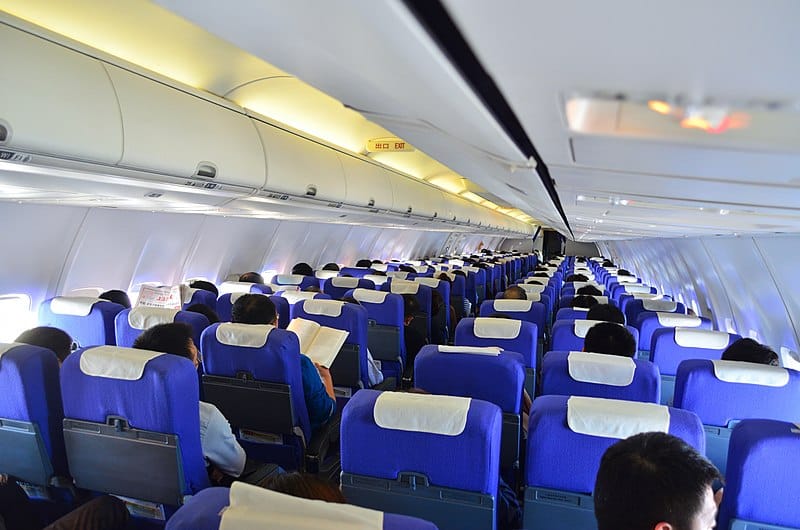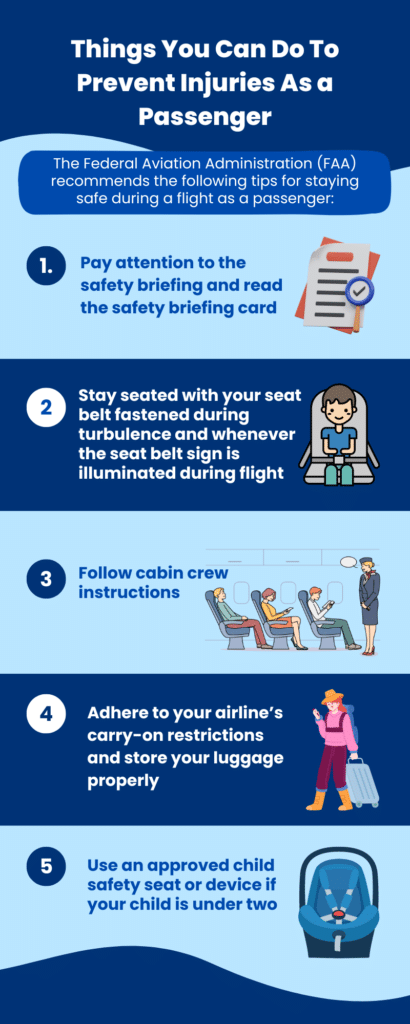
Injured on an Airplane?
While commercial plane injury events – including injuries from rough landings – are rare, they do occur. In the U.S., there are about 1,000 aviation injury events every year of which around 200 end up being fatal.
If you or a loved one were involved in an aviation injury event, you may be entitled to compensation.

Why Choose Us
When we take on an airplane injury case, we investigate every single detail.
Not only do our attorneys have vast experience settling aviation injury claims, but we also work with leading experts across the United States.
Our attorneys are passionate about helping injured victims. We work to get you the maximum compensation available under the law.
After an aviation injury event, you deserve to know about your legal rights, and how to protect them. Our team can help.
We are Ready to Help
Find out how we can help you by contacting us for a free consultation. Not only is your consultation free, but there is no obligation or upfront costs to hire us. You do not pay unless we win.
Types of Aviation Injury Events
Aviation injuries can occur in various forms, ranging from minor incidents to catastrophic events. Some of the most common types of incidents causing aviation injuries include:

- General Aviation Injury Events: General aviation injury events involve small private planes, including single-engine, multi-engine, and piston-powered aircraft.
- Commercial Aviation Injury Events: Commercial aviation injury events involve large passenger aircraft operated by commercial airlines.
- Helicopter Injury Events: Helicopter injury events can occur in various settings, including air ambulance operations, news and media coverage, law enforcement or military operations, and private helicopter flights.
- Air Traffic Incidents: Air traffic incidents can involve near-misses, collisions, or other incidents that occur in airspace, air traffic control errors, or communication failures between pilots and air traffic controllers.
- Airport Incidents: Airport incidents can include injury events or incidents that occur on airport grounds, such as runway incursions, collisions on the tarmac, ground support equipment failure, or incidents during boarding or deplaning.
- Unmanned Aircraft Systems (UAS) Injury Events: With the increasing use of UAS or drones for recreational, commercial, or industrial purposes, injuries involving drones have become more prevalent.
- Inflight and In-cabin injuries: These injuries can occur due to turbulence, unexpected movements of the aircraft, luggage falling from overhead compartments, or even negligence on the part of the airline or crew.
Many of these events can occur during take-off, landing, or in-flight and may result from factors such as pilot errors, mechanical failures, weather-related factors, or other causes, and may result in various types of injuries or fatalities for both the passengers and the crew.
Inflight and In-Cabin Injuries: An Overview
Inflight or in-cabin injuries are unfortunately not uncommon in the aviation industry. While air travel is generally considered safe, passengers can still suffer from various types of injuries during a flight.
Inflight injuries refer to injuries that occur while a passenger is in the air, typically caused by turbulence or unexpected movements of the aircraft. The most common inflight injuries include:

- Turbulence-related injuries: Turbulence can be caused by various factors, such as atmospheric pressure, jet streams, weather fronts, or thunderstorms, and can occur unexpectedly, even in clear skies. Turbulence can give an airplane a sudden jolt, which can cause injury to passengers and/or flight crew, resulting in cuts, bruises, and broken bones.
- Overhead bin injuries: Injuries can also occur when overhead bins are opened during the flight, as items might fall out and hit passengers.
- Burns: Spilling hot drinks or touching hot surfaces in the cabin may cause burns, which can range from minor to severe.
- In-flight medical emergencies: Passengers with pre-existing medical conditions may experience health emergencies during the flight that may require immediate medical attention and might lead to inflight injuries.
On the other hand, in-cabin injuries refer to injuries that occur within the cabin of an aircraft. These injuries can be caused by the passenger’s own actions or due to the negligence of airline staff. The most common in-cabin injuries include:
- Luggage-related injuries: Passengers may sustain injuries while lifting or carrying heavy luggage, such as back strains, sprains, or fractures.
- Slip and fall injuries: Slippery or wet floors, inadequate lighting, and poorly maintained carpets can cause passengers to slip and fall, resulting in injuries such as broken bones or head trauma.
- Food-related injuries: Eating contaminated or spoiled food can cause food poisoning, and may lead to vomiting, diarrhea, and dehydration.
In the United States, aviation-related injuries lead to around 1000 hospitalizations annually, with a mortality rate of 2% among in-hospital cases.
Things You Can Do To Prevent Injuries As a Passenger

The Federal Aviation Administration (FAA) recommends the following tips for staying safe during a flight as a passenger:
- Pay attention to the safety briefing and read the safety briefing card.
- Stay seated with your seat belt fastened during turbulence and whenever the seat belt sign is illuminated during flight.
- Follow cabin crew instructions.
- Adhere to your airline’s carry-on restrictions and store your luggage properly.
- Use an approved child safety seat or device if your child is under two.
Regulation of Air Travel and Aviation Safety in the U.S.
The two primarily responsible federal agencies regulating air travel and aviation safety in the United States are the Federal Aviation Administration and the National Transportation Safety Board.
The Federal Aviation Administration (FAA) is the primary agency responsible for regulating civil aviation within the U.S. It oversees a wide range of activities, including the certification of aircraft, pilots, and mechanics, regulation of air traffic, enforcement of safety standards, and investigation of injury events and incidents in the aviation industry. The FAA works to ensure the safe and efficient operation of the national airspace system and sets standards for aircraft design, maintenance, and operations.
On the other side, the National Transportation Safety Board (NTSB) is an independent federal agency responsible for investigating and determining the probable cause of transportation injury events, including aviation incidents, in the United States. The NTSB conducts thorough investigations to identify safety issues, makes recommendations for improvements, and promotes safety in the aviation industry. The NTSB’s findings and recommendations are critical in improving aviation safety and preventing injury events in the future.
Under which situations should the operator of an aircraft notify the nearest NTSB?
Some of the incidents under which the operator of an aircraft should immediately notify the nearest NTSB include:
- Flight control system malfunction or failure of structural components.
- An injury or illness causing any required flight crew member the inability to perform their regular flight duties.
- Aircraft collide during flight.
- Inflight fire.
The NTSB should also be notified if an aircraft is overdue and is believed to have been involved in an injury event.
The notification must include, when possible:
- Type, nationality, and registration marks of the aircraft.
- Name of owner and operator of the aircraft.
- Name of the pilot in command.
- Date and time of the injury event, or incident.
- Aircraft’s point of intended landing and last point of departure
- Aircraft’s position with reference to some easily defined geographical point.
- The number of persons aboard, killed, and/or seriously injured.
- Nature of the injury event, or incident, the weather, and the extent of damage to the aircraft so far as is known; and
- A description of any dangerous articles carried, including any explosives or radioactive materials
In the case of an aviation disaster, the NTSB along with the air carrier involved may provide support and assistance to survivors and family members of involved loved ones.
Legal Implications of Aviation Injuries
Aviation injuries can involve complex legal issues. Some of the key legal implications of aviation injuries involve liability and compensation.
Determining liability in aviation injury cases can be challenging, as multiple parties may be responsible, including the airline, aircraft manufacturer, pilot, air traffic controller, maintenance crew, or other parties.
Victims of aviation injuries may be entitled to compensation for their damages, including medical expenses, lost wages, pain and suffering, emotional distress, and other losses.
An experienced aviation injury lawyer can help you both identify the responsible parties and pursue fair compensation for your specific case.
We are Ready to Help
Find out how we can help you by contacting us for a free consultation. Not only is your consultation free, but there is no obligation or upfront costs to hire us. You do not pay unless we win. At National Injury Center we are here to help and offer FREE legal consultations. If you want to learn more about your rights and options, fill out our form today.
What You Can Do If You Were Involved In An Aviation Injury Event
If you or a loved one were involved in an aviation injury event, whether as a passenger, crew member, pilot, or bystander, it is important to know what steps you can take to protect your rights and seek appropriate compensation for your damages.
Dealing with the aftermath of an aviation injury can be overwhelming, but taking prompt and informed action can make a significant difference in the outcome of your case.
Seeking legal assistance from an experienced aviation injury lawyer can provide you with the guidance and representation you need to navigate the complexities of aviation injury cases and pursue a fair resolution.
Sources
- https://www.bts.gov/content/us-general-aviationa-safety-data
- https://www.faa.gov/air_traffic/publications/atpubs/aim_html/chap7_section_7.html
- https://www.faa.gov/newsroom/turbulence
- https://www.ncbi.nlm.nih.gov/pmc/articles/PMC2810202/
- https://www.ntsb.gov/tda/tdadocuments/federal-family-plan-aviation-disasters-rev-12-2008.pdf
We are Ready to Help
Find out how we can help you by contacting us for a free consultation. Not only is your consultation free, but there is no obligation or upfront costs to hire us. You do not pay unless we win.